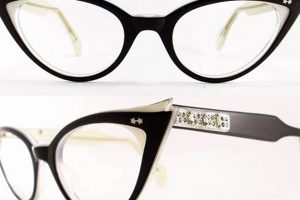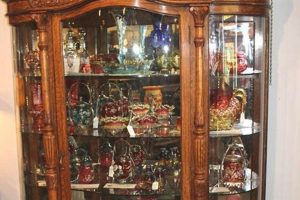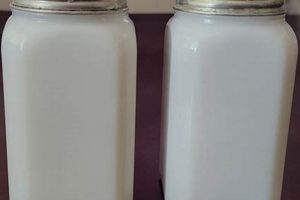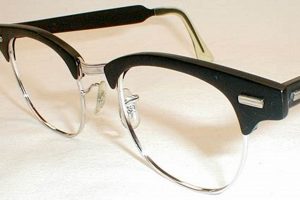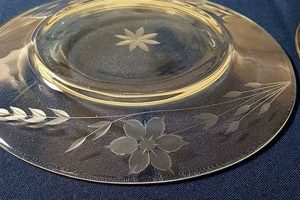Eyewear from a bygone era, specifically those produced by the iconic Ray-Ban brand, often hold significant appeal for collectors and fashion enthusiasts alike. These spectacles, manufactured in previous decades, are characterized by design elements and construction techniques distinct from contemporary models. For example, pre-1980s Ray-Ban frames frequently feature thicker acetate or metal components, and lenses made with glass, reflecting the manufacturing standards and material availability of that time.
The enduring popularity of these older optical devices stems from multiple factors. Their designs often represent classic and timeless aesthetics, offering a stylistic alternative to modern trends. Moreover, these items represent a tangible connection to the past, possessing a nostalgic value for many individuals. Furthermore, the quality of materials and craftsmanship in older manufacturing periods can contribute to the durability and longevity of the eyewear, making them desirable and sought-after pieces.
The following discussion will delve into aspects such as identifying authentic articles, assessing their condition, understanding their market value, and exploring the care and preservation methods appropriate for maintaining their unique characteristics and historical significance. Considerations for purchasing and verifying authenticity will be addressed to aid potential buyers.
The acquisition of older Ray-Ban optical frames requires careful consideration to ensure authenticity and value. Several factors should be evaluated before making a purchase.
Tip 1: Examine Markings and Engravings: Authentic items typically feature specific markings, including the Ray-Ban logo on the lens and frame. The font, placement, and clarity of these markings should be meticulously scrutinized for inconsistencies, which may indicate a reproduction.
Tip 2: Assess Material and Construction: Older frames were often constructed using different materials than contemporary models. Investigate the frame’s material composition, noting the weight, texture, and any signs of wear consistent with the purported age. Glass lenses were common in the past and can be an indicator of age.
Tip 3: Investigate Hinge Construction: Hinge designs varied over time. Researching the hinge types used in different eras of Ray-Ban production can provide valuable insights into the item’s potential authenticity. Look for robust, well-constructed hinges, which were characteristic of older manufacturing processes.
Tip 4: Research Model Numbers and Frame Styles: Familiarize oneself with the model numbers and frame styles produced by Ray-Ban throughout its history. Correlating the model number with the frame style and period of production is crucial for verifying legitimacy. Consult vintage catalogs and online resources for accurate information.
Tip 5: Inspect the Case and Packaging: Original cases and packaging, if available, can offer further validation. Examine the case’s logo, material, and construction for consistency with the purported age of the eyewear. The presence of original paperwork or pamphlets adds to the item’s provenance.
Tip 6: Seek Expert Appraisal: Consider consulting with an experienced appraiser specializing in vintage eyewear. A professional can provide an objective assessment of the item’s authenticity, condition, and market value, offering crucial guidance before a significant purchase.
Tip 7: Purchase from Reputable Sources: Prioritize purchasing from reputable dealers or auction houses known for their expertise in vintage collectibles. Established sellers are more likely to offer authentic items and provide guarantees or returns policies.
Careful scrutiny of markings, materials, construction details, and provenance documentation is essential to avoid acquiring counterfeit or misrepresented items. Seeking expert advice and purchasing from trustworthy sources will further mitigate risk.
The subsequent sections will address specific aspects of cleaning, restoring, and properly storing older optical devices to preserve their integrity and value.
1. Authenticity indicators.
Determining the authenticity of older Ray-Ban eyewear requires a meticulous examination of several indicators, each contributing to a comprehensive assessment of the item’s origin and age. These indicators collectively assist in differentiating genuine articles from reproductions.
- Lens Markings and Engravings
The presence and characteristics of lens markings, specifically the Ray-Ban logo, are primary indicators of authenticity. Older lenses often feature the “BL” etching (Bausch & Lomb, the original manufacturer) which is absent in later Luxottica produced models. The font, size, and placement of the logo must align with established historical standards. Any deviation may indicate a counterfeit.
- Frame Markings and Engravings
Frame markings, typically found on the inner temples or bridge, provide model numbers, frame size, and manufacturing location. These markings should be clear, legible, and consistent with documented Ray-Ban production practices for the purported era. Incorrect font types, misspellings, or the absence of expected markings raise significant concerns regarding authenticity.
- Hinge Construction and Hardware
Hinge construction varied across different production periods. Certain hinge styles, such as the “diamond hinge” or specific barrel hinge designs, are characteristic of particular eras. The material and finish of the hardware (screws, rivets) should also be scrutinized. Rust, corrosion, or the use of non-original hardware can indicate either damage or potential fabrication.
- Material Composition and Quality
The materials used in the construction of older Ray-Ban frames, such as acetate or metal alloys, differed from contemporary materials. Examining the quality, weight, and texture of these materials provides clues to authenticity. For example, early acetate frames often exhibit a richer color depth and a different feel compared to modern reproductions.
The presence of authentic markings, coupled with appropriate material composition and construction techniques, constitutes compelling evidence of the genuine nature of Ray-Ban eyewear. While no single indicator guarantees authenticity, a convergence of these factors significantly strengthens the likelihood of its genuine origin.
2. Frame Material Degradation
Frame material degradation is a critical consideration when assessing the condition and value of older Ray-Ban eyewear. The passage of time, coupled with environmental factors and usage patterns, inevitably leads to the deterioration of frame materials, affecting the structural integrity and aesthetic appeal of optical devices. This degradation manifests differently depending on the materials used in the frame’s construction, such as acetate, metal alloys, or composite materials.
Acetate frames, prevalent in many older models, are susceptible to discoloration, warping, and embrittlement. Prolonged exposure to ultraviolet radiation causes fading and chalking of the surface. Contact with chemicals, such as solvents or cleaning agents, can accelerate the degradation process, resulting in cracking and structural weakness. Metal alloy frames, while generally more robust, are prone to corrosion, pitting, and the development of oxidation layers. Brass components, often used in hinges and detailing, are particularly susceptible to tarnishing and the formation of verdigris. These forms of material degradation directly impact the collectability and usability of antique Ray-Ban eyewear, necessitating careful inspection and appropriate preservation strategies.
Understanding the specific mechanisms of frame material degradation is crucial for both collectors and restorers of older optical frames. Implementing preventive measures, such as proper storage in controlled environments and avoiding harsh cleaning agents, can significantly extend the lifespan of the frame. In cases of advanced degradation, professional restoration techniques may be employed to stabilize the material and restore the frame’s original appearance, preserving its historical value. Without understanding the impact and means of mitigation, the longevity and worth of the item is in jeopardy.
3. Lens Clarity importance.
The optical clarity of the lenses within spectacles from earlier eras, especially those produced by Ray-Ban, directly influences their usability, value, and collectability. Lens clarity dictates the wearer’s visual acuity and comfort, representing a fundamental aspect of eyewear functionality. Degraded or damaged lenses, characterized by scratches, clouding, or discoloration, impair vision and diminish the overall wearing experience. A specimen featuring pristine lenses commands a premium compared to one with compromised clarity, reflecting the importance placed on this feature by both collectors and prospective users. Consider, for instance, two otherwise identical Aviator models from the 1970s; the example with lenses free from significant imperfections will invariably be more desirable and valuable.
Beyond visual performance, lens clarity is crucial in preserving the original aesthetic and intended purpose. Vintage Ray-Ban eyewear embodies design choices and intended performance characteristics specific to its era. Obscured vision distorts the intended visual experience. Furthermore, replacement of lenses with non-original components, even if optically clear, alters the authenticity and reduces its collectable value. The material composition of vintage lenses, often mineral glass, contributes to their unique optical properties and durability. A lens replacement, even if improving clarity, can fundamentally detract from the item’s historical significance and authenticity. Restoration processes aimed at enhancing lens clarity, when ethically and professionally executed, can mitigate damage without compromising authenticity; however, this presents its own set of challenges.
In summary, lens clarity represents an indispensable attribute of optical devices from earlier production periods, affecting their usability, value, and collectability. While complete restoration of damaged lenses may pose challenges to authenticity, maintaining and preserving original lens clarity is of critical importance. It should always be considered when acquiring, appraising or restoring.
4. Style period characteristics.
Style period characteristics significantly influence the desirability and value of older Ray-Ban optical devices. Distinct design trends, manufacturing techniques, and material choices defined specific eras, creating signature aesthetics that are now highly sought after by collectors and fashion enthusiasts alike. Recognition of these style period markers is essential for accurately dating and appraising vintage frames.
- The Pre-War Era (1930s-1940s)
Frames from this period often exhibit a utilitarian aesthetic, characterized by robust metal construction and functional designs. Aviator models, originally developed for military pilots, are prominent examples. Key features include teardrop-shaped lenses, adjustable nose pads, and cable temples. The materials used, typically gold-filled or rhodium-plated metals, reflect the manufacturing capabilities of the time. These early iterations represent a seminal chapter in the history of the brand and are prized for their historical significance.
- The Post-War Boom (1950s-1960s)
This era witnessed a diversification of frame styles and materials. Acetate frames gained popularity, offering a wider range of colors and shapes. The Wayfarer, introduced in 1952, became an iconic symbol of the era, characterized by its bold, trapezoidal shape. Browline frames, combining metal and acetate elements, were also prevalent. These stylistic shifts reflected broader cultural trends towards optimism and experimentation.
- The Decade of Decadence (1970s-1980s)
Oversized frames, geometric shapes, and vibrant colors defined this period. The General, a variant of the Aviator, featured a squared-off lens shape and a bolder frame design. Plastic frames were increasingly common, often incorporating gradient lenses and decorative embellishments. This era’s styles mirror the flamboyant fashion trends of the time. Specific models with unique colorways or limited production runs are highly coveted by collectors.
- The Return to Classicism (1990s)
A renewed appreciation for classic styles marked this decade. Smaller, more streamlined frames gained favor, often drawing inspiration from earlier eras. The Clubmaster, a revival of the Browline frame, experienced a resurgence in popularity. Metal frames with understated designs were also prevalent. This period reflects a move away from the excesses of the previous decades and a return to timeless elegance.
Understanding the stylistic nuances of each period enables collectors and enthusiasts to identify authentic frames and appreciate their historical context. Recognizing specific design elements, material choices, and manufacturing techniques provides valuable insights into the evolution of the Ray-Ban brand and its enduring influence on eyewear fashion. These temporal markers will assist in verifying historical consistency for restoration and evaluation.
5. Collector desirability.
Collector desirability exerts a substantial influence on the valuation and preservation of older Ray-Ban optical devices. This desirability stems from a combination of factors, including rarity, condition, historical significance, and iconic design. The effect of strong collector demand is manifest in elevated market prices and increased efforts to authenticate, restore, and protect these items. Certain models, particularly those with limited production runs or unique design elements, command significantly higher prices due to their scarcity. For instance, specific examples from the Bausch & Lomb era, pre-dating Luxottica’s acquisition of the brand, are often more desirable due to their historical association with the company’s original manufacturing standards and aesthetic sensibilities. The demand from collectors directly impacts the incentive to identify forgeries and preserve authentic pieces.
The importance of collector desirability is further underscored by the specialized market that has developed around these objects. Dedicated online forums, auction houses, and appraisal services cater specifically to the needs of collectors, providing platforms for buying, selling, and authenticating older Ray-Ban eyewear. These platforms facilitate the dissemination of knowledge about identifying features, such as specific markings, hinge designs, and material compositions, enabling collectors to make informed purchasing decisions. The collectability is not simply an attribute; it is an organizing principle around which the market operates. Furthermore, the prices achieved at auction or private sales serve as benchmarks for valuing other specimens, creating a feedback loop that reinforces the desirability of rare or well-preserved examples.
In summary, collector desirability is a key component influencing both the financial value and preservation efforts surrounding vintage Ray-Ban eyewear. Scarcity, condition, and historical association all contribute to increased collector demand, which in turn drives market prices and incentivizes the authentication and restoration of these historical artifacts. Understanding the dynamics of collector desirability is crucial for both potential buyers and those seeking to preserve the legacy of this iconic brand. The challenges faced often involve authentication and ethical restoration of degraded materials.
Frequently Asked Questions
The following questions address common inquiries and concerns regarding the identification, valuation, and care of older Ray-Ban optical devices.
Question 1: How can authenticity of older Ray-Ban frames be definitively verified?
Authenticity verification necessitates a multi-faceted approach, including meticulous examination of frame and lens markings, assessment of material composition, and comparison with documented production specifications. Expert appraisal is advisable when uncertainty persists.
Question 2: What factors most significantly impact the valuation of specimens from past eras?
Rarity, condition, historical significance, and stylistic desirability exert the most substantial influence on valuation. Models with limited production runs or unique design features command premium prices.
Question 3: What are the recommended cleaning procedures for preserving the integrity of older frame materials?
Gentle cleaning with a soft, lint-free cloth and mild, pH-neutral soap is recommended. Abrasive cleaners and solvents should be strictly avoided to prevent damage to frame materials and lens coatings.
Question 4: Are lens replacements advisable for eyewear from previous periods with compromised optical clarity?
Lens replacements, while enhancing optical clarity, can diminish the historical authenticity and collectable value. Replacement with lenses matching original specifications is preferable; however, professional consultation is advised.
Question 5: How should they be stored to mitigate material degradation?
Storage in a cool, dry environment, away from direct sunlight and extreme temperature fluctuations, is crucial. Protective cases or pouches prevent scratches and physical damage.
Question 6: What are the ethical considerations surrounding the restoration of authentic but degraded pieces?
Restoration should prioritize preservation of original materials and construction techniques. Any alterations should be clearly documented, maintaining transparency regarding the item’s history and originality.
Careful attention to these factors ensures the longevity and preservation of these pieces.
The following section will present a detailed guide on resources for further exploration.
Conclusion
The preceding analysis has explored various facets related to eyewear from prior periods, focusing on the esteemed Ray-Ban brand. Key considerations include authenticity verification, condition assessment, material degradation, style period characteristics, and factors impacting collector desirability. Proper identification, valuation, and preservation techniques are paramount for maintaining their historical integrity and economic value.
Continued research, responsible stewardship, and informed acquisition practices are crucial for ensuring the appreciation and preservation of these artifacts for future generations. The legacy endures, demanding respect and diligence from enthusiasts and custodians alike.


